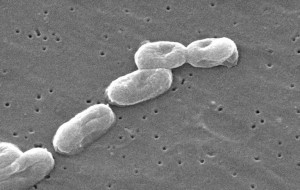
New research may change the way we culture and treat infections. (Burkholderia cepacia complex, CDC/Wikimedia Commons)
A boy with cystic fibrosis develops a potentially deadly Burkholderia dolosa infection in his lungs. Various genetic mutations allow some bacterial strains to survive assaults from his immune system and antibiotics, while others perish. Eventually, the strongest mutant dominates the B. dolosa colony.
Right? Maybe not, say the authors of a new study. Examining sputum samples from infected patients, they found that dozens of different kinds of B. dolosa may coexist in that boy’s lungs—each adapting and surviving in different ways. The findings, published last month in Nature Genetics, warn of possible shortfalls in the way infections are currently cultured and treated.
“We found that when a pathogen like B. dolosa infects us, it diversifies. Many cells discover ways to survive, and these successful mutants coexist,” says senior author Roy Kishony, PhD, professor of systems biology at Harvard Medical School. “This suggests we can reject the model in which a single mutant starts to grow better than everyone else and takes over.”
“These bacteria have incredible diversity and an amazing power to evolve and adapt to different environmental stressors,” adds co-senior author Gregory Priebe, MD, of the Division of Critical Care Medicine at Boston Children’s and an infectious diseases researcher at Brigham and Women’s Hospital. “The study may change how we think about infections.”
Peaceful co-existence
The study grew out of a puzzling discovery made two years ago by most of the current team—including Kishony, Priebe, co-senior author Alexander McAdam, MD, PhD, director of Boston Children’s Infectious Diseases Diagnostic Laboratory and first author Tami Lieberman, a doctoral student in Kishony’s lab.
They were examining bacteria from cystic fibrosis patients who had acquired chronic B. dolosa infections, expecting the B. dolosa cells from later samples to look like genetic descendants of those in earlier samples. Instead, the family tree was all mixed up.
“Something was fishy,” says Kishony. He suspected the answer to the riddle lay in the way bacteria are cultured from a patient’s sputum.
Clinical labs typically select a small number of colonies for testing, each grown from an individual cell. If all or most of cells in the sample have the same genome, then those few colonies are representative of the patient’s bacterial population. But if there are a dozen or more B. dolosa variants in the mix, then doctors and researchers only see a fraction of the picture, like the proverbial blind men feeling different parts of the elephant.
To get a true picture, the team gathered new sputum samples from five cystic fibrosis patients who have harbored decade-long B. dolosa infections. Instead of studying single isolates, the researchers cultured many cells from each patient and conducted two kinds of genetic sequencing (colony resequencing and deep population sequencing) to reveal B. dolosa’s genetic diversity.
“There was so much more diversity than we expected,” says Lieberman. “And the diversity appeared to have existed for many years.”
In 29 isolates cultured from a single sputum sample from one patient, Lieberman found six distinct B. dolosa lineages and 188 different mutations. Only 10 mutations were shared by every isolate.
“Because the different lineages coexist for a long time, we can read the record of what the bacteria adapted to,” says Kishony.
In one patient alone, the team counted three distinct mutations in a B. dolosa gene that makes a penicillin-binding protein, suggesting that the bacteria employed several strategies to survive treatment with penicillin-related drugs. Other bacteria had mutations in oxygen-sensing and iron-scavenging genes.
“We found we can get more information by looking carefully at a single snapshot than we could from following an infection at different times,” says Kishony. “We can learn a lot about the past without needing old samples.”
Personalized antibiotics?
The great diversity of bacteria in these B. dolosa samples suggests that clinicians may need to change how bacterial cultures are performed, how they select treatments for bacterial infections and how epidemiologists piece together bacterial transmission from person to person.
“Clinical laboratories might need to analyze a broad representation of a bacterial population in a patient to understand his or her longstanding infection and select the appropriate antibiotics,” says McAdam. “The hope is that whole-genome sequencing of bacteria will shed light on characteristics that have not been routinely investigated, such as the mechanisms by which the bacteria survive in the lungs and cause damage to the host tissue.”
In the future, the team intends to investigate whether genetic variants in B. dolosa can be correlated to different physical manifestations of disease. “We may be headed in a direction where we want to look at variations in the pathogen’s genome in different people,” says Kishony.
Since the team studied only B. dolosa, “it’s open to be seen how generalizable our findings are to other pathogens, both in long-term and short-term infections,” says Kishony. He and his colleagues have already started looking at Mycobacterium tuberculosis and Pseudomonas aeruginosa.







